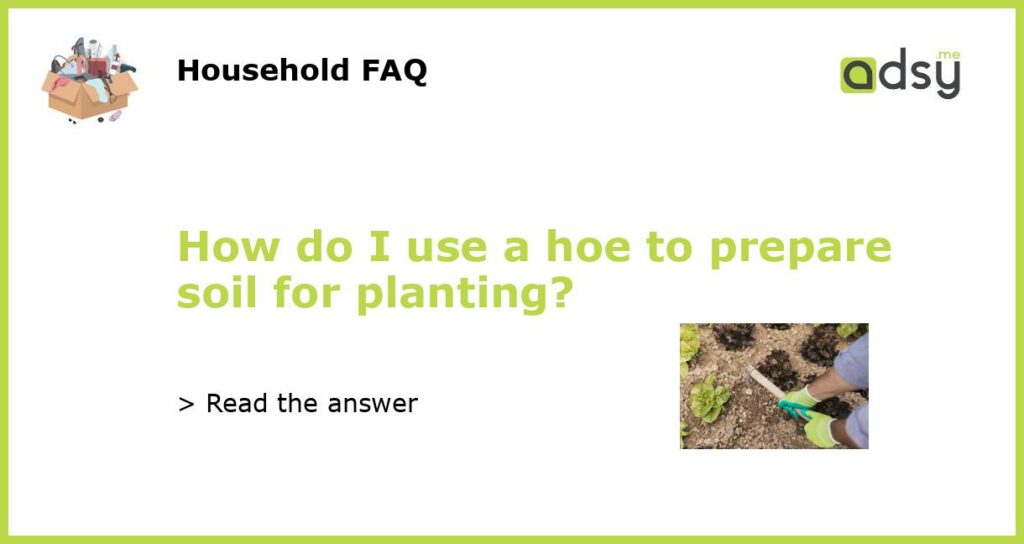Understanding the Basics of Using a Hoe for Soil Preparation
Using a hoe is a common and effective method for preparing soil for planting. Whether you’re a beginner gardener or have some experience, knowing the right techniques for using a hoe can help ensure successful plant growth. In this article, we will guide you through the step-by-step process of using a hoe to prepare soil for planting.
Choosing the Right Hoe for Soil Preparation
Before you begin using a hoe, it’s important to choose the right type for your needs. There are several different types of hoes, each designed for specific tasks. The most common types of hoes for soil preparation are the standard hoe and the garden hoe.
The standard hoe, also known as a traditional hoe, has a flat blade on one end and a sharp edge on the other. This type of hoe is best suited for breaking up compacted soil, removing weeds, and preparing large areas for planting.
The garden hoe, on the other hand, has a smaller blade and is ideal for smaller-scale gardening tasks. This type of hoe is best suited for precision work, such as removing weeds between plants or creating furrows for planting seeds.
Consider the size of your garden and the specific tasks you need to accomplish when choosing the right hoe for soil preparation. It’s also important to select a hoe with a comfortable handle that allows for easy grip and maneuverability.
Step-by-Step Guide to Using a Hoe for Soil Preparation
Once you have selected the right hoe for your needs, follow these step-by-step instructions to prepare your soil for planting:
- Begin by clearing the area of any large rocks, debris, or existing plants that you do not want to keep.
- Hold the hoe with both hands, placing one hand on the handle near the top and the other hand closer to the blade.
- Position the blade of the hoe at a slight angle, with the sharp edge facing downward.
- Using a firm grip, push the hoe into the soil, angling it slightly towards you.
- In a continuous motion, pull the hoe toward you, breaking up the soil and removing any weeds or grass.
Repeat this process across the entire area you plan to plant, working your way from one end to the other. Take breaks as needed, especially if you are working on a large area, to avoid overexertion.
Tips for Efficiently Using a Hoe for Soil Preparation
While using a hoe is a relatively simple process, there are some tips and tricks that can help you maximize efficiency and effectiveness:
- Use your body weight to your advantage by leaning into the hoe as you push it into the soil.
- Take care not to remove too much soil at once, as this can disturb the soil structure and nutrient levels.
- If you encounter particularly stubborn weeds or roots, use the sharp edge of the hoe to slice through them.
- Consider using a hoe with a longer handle if you have a large garden area, as this can help reduce strain on your back and arms.
- Regularly clean and sharpen the blade of your hoe to maintain its effectiveness.
By following these tips, you will be able to efficiently and effectively use a hoe for soil preparation, ensuring a healthy environment for your plants to thrive.
Other Methods for Soil Preparation
While using a hoe is a popular choice for soil preparation, there are other methods you can consider depending on your specific needs and preferences. Some alternative methods for soil preparation include:
- Tilling: Using a tiller or garden fork to loosen the soil and break up clumps.
- Double-digging: Digging individual trenches and loosening the soil by turning it over.
- Sheet mulching: Layering organic materials, such as newspaper and compost, on top of the soil to improve its fertility.
- No-till gardening: Leaving the soil undisturbed and focusing on building and maintaining healthy soil structure through organic matter and composting.
- Using raised beds: Creating elevated planting areas with amended soil for improved drainage and nutrient levels.
Consider exploring these alternative methods to find the one that best suits your gardening goals and preferences. Remember to always choose the method that will create the healthiest growing environment for your plants.






